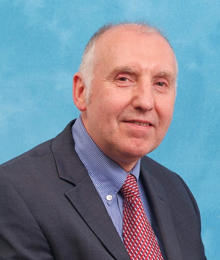An interview with Professor David Hornby
David Hornby is a Professor of Biochemistry at the University of Sheffield. In this interview, he tells us more about his research on restriction and modification enzymes, why this is important to microbiology and some of the different outreach projects he is involved in.

Tell us more about your research.
I began my research career as a Biochemist working on enzyme mechanisms, in particular Glutamate Dehydrogenases. Most of the work published during the 1970s focused on the mammalian enzyme, but my supervisor recognised the opportunity for extending the enzymology into microbial systems. And so, I began a series of comparative experiments with the bovine enzyme and the enzyme from the anaerobes Peptostreptococcus asaccharolyticus and Clostridium symbiosum, both of which utilise a specialised glutamate fermentation route – the hydroxyglutarate pathway. It turned out that C. symbiousum was easier to work with, and we went on to crystallise the bacterial enzyme. This work informed our understanding of this important reaction, until very recently (some 30+ years later) the mammalian enzyme structure was finally solved.
It was the advantages of working with microbes, together with the developments in molecular cloning, which led me to move into bacterial restriction and modification — working at the Biozentrum University of Basel on complex restriction and modification systems in E.coli — I decided that microbiology at the University of Sheffield, was going to be an interesting source of both experimental problems and materials.
Since starting my own laboratory in 1986, I have used E.coli to express proteins for a variety of structure function studies; and more recently, work on restriction and modification enzymes has revealed a mutant DNA methyltransferase, that provokes a mutational rescue response in vivo. This once again demonstrates that microbes can still unlock many secrets.
After years of trying to rationalise protein structure and function using site-directed mutagenesis, my lab is currently developing random mutagenesis methods to investigate the relationship between primary structure and protein function.
Why is this research important?
The experimental accessibility of prokaryotes, combined with the amazing track record of discovery from restriction and modification to CRISPR Cas9, justifies my continued interest, and omic technologies make it possible to explore deeper questions. By combining random mutagenesis with strong methods of selection and modelling, I feel a robust understanding of the relationship between the sequences of genes and their encoded products will emerge. Being able to predict structure from sequence remains a key goal of biologists, and this in turn, will help us reduce the time it takes to deliver new medicines.Can you tell us a bit more about any outreach activities you have undertaken to promote your research?
I am currently spending 60% of my week working in a multi-school academy in Merseyside, supporting science education amongst teachers, and indirectly delivering extracurricular activities for students from Year 9–13.
I am a founding member of the Northern Schools Trust and also make regular contributions to my local Sci Bar – writing blog posts and giving talks, and am a Trustee of the Catalyst Science Discovery Centre, where I also deliver lab-based sessions.
Why does microbiology matter?
Genomics has dominated the scientific headlines since The Human Genome Project was launched 30 years ago. However, perhaps unexpectedly, the fundamental dependence we have on microbes in sustaining our health and the biosphere, has been one of the most compelling narratives to emerge from genome studies.
Microbes offer novel manufacturing solutions as bioreactors, but they also pose threats to health as our portfolio of available antibiotics become blunt instruments. It is clear that we can’t live without microbes, and yet we are often challenged by them. There is no doubt in my mind, that microbiology provides a rich seam of interesting scientific phenomena, and our ability to harness and control such phenomena will play an increasingly important role in the sustainable development of mankind.


